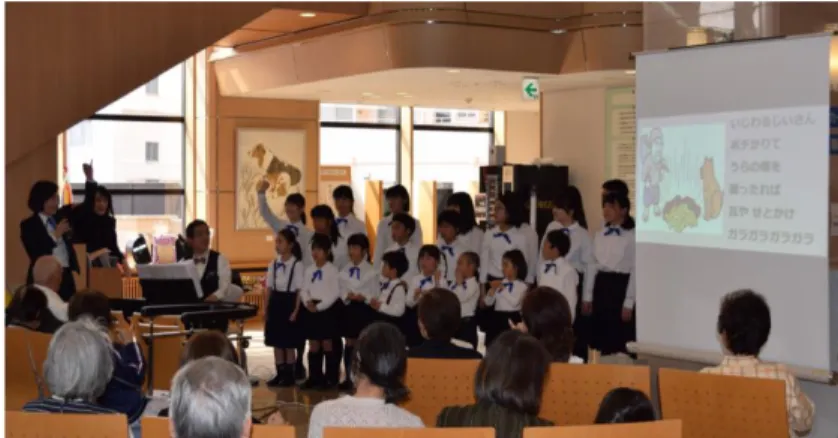Pubtexto Publishers | www.pubtexto.com 1 Int J Case Rep Clin Image Open Access
International Journal of Case Reports and Clinical Images
Volume 1 Issue 1 Clinical Image
Music Therapy in the Hospital to Heal Patients for Training of Speech and Swallow
Function
Bando H*, Yoshioka A, and Nishikiori Y
Shikoku Division of Integrative Medicine Japan (IMJ), Nakashowa 1-61, Tokushima 770-0943, Japan Article Info
Article History: Received: 30 March, 2019; Accepted: 15 April, 2019; Published: 21 April, 2019
*Corresponding author: Hiroshi Bando, Shikoku Division of Integrative Medicine Japan (IMJ), Nakashowa 1-61, Tokushima 770-0943, Japan; Tel: +81-90-3187-2485;
Fax: +81-88-603-1030; E-mail: pianomed@bronze.ocn.ne.jp
Copyright: © 2019 Bando H, et al. This is an open-access article distributed under the terms of the Creative Commons Attribution License, which permits unrestricted use, distribution, and reproduction in any medium, provided the original author and source are credited.
Clinical Images
Recently, the importance of patient-oriented medicine has been recognized. There are some kinds of medical practice such as primary care medicine, holistic medicine, psychosomatic medicine and integrative medicine (IM). IM consists of ordinary Western medicine and complementary and alternative medicine (CAM). Among them, music therapy (MT) has been one of the most accepted treatments.
The development of music therapy in Japan were owing to Dr. Shigeaki Hinohara, International St. Luke Hospital, and Tokyo. He was a respected physician loved by anyone with excellent philosophy Hinohara-ism through the New Elderly Association (NEA). As his disciple, authors have continued various activity related to Hinohara-ism, music activity, art therapy, enlightening of health and patient-oriented medicine.
On the other hand, there have been recently various needs for the role of the hospital. They include not only necessary therapy for the diseases but also possible projects for caring patients mentally and psychologically according to the condition of each patient. Gradually, the need for such activities has grown and the service and cooperation of hospital staffs has been essential. Combining the above, the authors had the opportunity to give a hospital lobby concert with music therapy session. We report the outline and investigate the power of the music for human body and mind. The presentation of music therapy concert was performed at the lobby of Tokushima municipal hospital, Tokushima, Japan. It lasted for 60 minutes including the guidance of music therapy, comment for the power of the music and old Japanese folk songs (Figures 1 and 2) [1].
Patients also sang favorite songs together with the children. Furthermore, children’s choir sang the famous classic music, “An die Freude” from the Symphony No.9 “Choral” by Ludwig van Beethoven. Furthermore, we presented how to prevent aspiration and dysarthria in aged people. There are clinically effective practice method by speaking and singing of the pronunciation of
pa-ta-ka-ra. It can strengthen the function of lips, tongue, pharynx and larynx [2]. Dual tasks can be simultaneously performed in addition to the movement of hands and legs accompanied by rhythmical music. These may become beneficial stimuli for the patients with mild cognitive impairment (MCI) and dementia [3]. In summary, music therapy session has the possibility for developing various human functions for better quality of life (QOL) and significant and meaningful life.
Figure 1: Music therapy session in Tokushima municipal hospital, Tokushima, Japan.
Citation: Bando H, Yoshioka A, Nishikiori Y (2019). Music Therapy in the Hospital to Heal Patients for Training of Speech and Swallow Function. Int J Case Rep Clin Image 1( 1): 102
Pubtexto Publishers | www.pubtexto.com 2 Int J Case Rep Clin Image
References
1. Bando H, Yoshioka A, Nishikiori Y. Music Therapy Session in the Hospital would Relax, Sooth and Heal the Heart. J Integrative Med Ther. 2018; 5: 1.
2. Warth M, Koehler F, Weber M, Bardenheuer HJ, Ditzen B, Kessler J. Song of Life (SOL) study protocol: a multicenter,
randomized trial on the emotional, spiritual, and psychobiological effects of music therapy in palliative care. BMC Palliative Care. 2019; 18: 14.
3. Bando H. Music therapy and internal medicine Progress in clinical medicine. Asian Med J. 2001; 44: 30-352.
